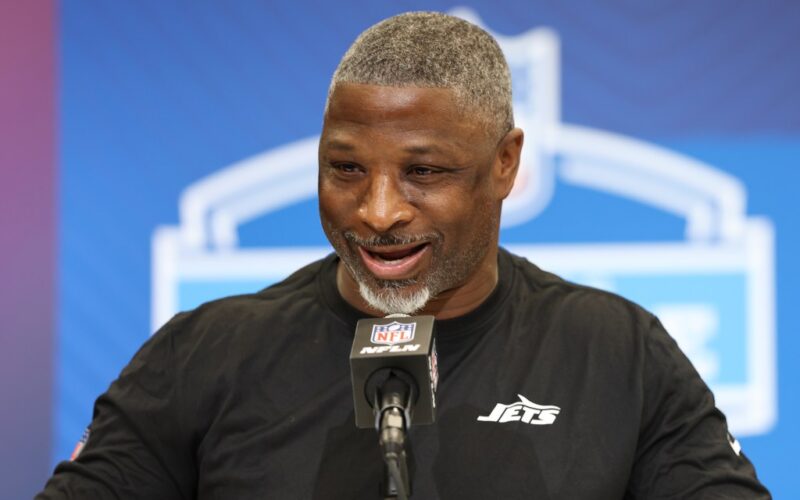On Monday, the Jets began Phase 3 of their offseason program, which is referred to as organized team activities (OTAs).
Phase 1 of the offseason program consisted of meetings, strength and conditioning, and physical rehabilitation. The second phase included individual group drills.
Like the first two phases, there will be no live contact during OTAs or the mandatory minicamp, which will take place from June 10 to 12. However, the Jets will have 10 OTAs in which 7-on-7, 9-on-7, and 11-on-11 drills are allowed.
Here are the key players and aspects to watch during the next four weeks:
Glenn’s interaction with players
During rookie minicamp, there was a notable difference between Jets coach Aaron Glenn and his predecessor, former coach Robert Saleh. Unlike Saleh, who would typically watch practice with little interaction at times with players, Glenn was actively teaching during the two-day minicamp.
Practice was also moving faster, with Glenn and his assistant coaches giving players low-fives after plays. Glenn also moved from one position group to another during team drills. During his final year with the Jets, Saleh mainly stuck around the offense during media availabilities in OTAs and training camp.
Glenn told reporters during the NFL Annual Meeting in March that his first goal during his first spring was to change the Jets’ culture.
“I’m not here to talk about the playoffs,” Glenn said. “I’m not here to talk about the Super Bowl when the players first get in. To me, it’s the process of actually making it that point.
“The two things I want to make sure we do first and foremost is establish the culture that we’ve been talking about and try to create a building environment.”
Although it will take over a month to change a team’s culture, OTA practices often set the tone during the early stages. One of the reasons the Jets hired Glenn was that he has been defined as a culture builder and a leader of men.
The Jets certainly need a culture change after a 14-season playoff drought, the longest in North American sports. Ultimately, Glenn’s tenure will be defined by his win-loss record. However, OTA practices could be an excellent way to determine how quickly players buy into his program.
Justin Fields’ accuracy
After the Jets signed Fields to a two-year, $40 million contract with $30 million guaranteed, Glenn said they want to let him play quarterback.
“That’s what he’s always wanted to do,” Glenn said. “I’m not saying he hasn’t had a chance to play that, do that in other places.
“That’s not my issue. I know what I want to do with that player. Obviously want to utilize his legs but want to give him a chance to go out there and play quarterback.”
During his four seasons in the league, Fields hasn’t had the best support around him. He was drafted 11th overall in the 2021 NFL Draft, but the Bears didn’t have many skilled players around him. Chicago also changed coaches from Matt Nagy to Matt Eberflus before Fields was traded to the Steelers last offseason.
In three seasons with the Bears, Fields passed for 6,674 yards, 40 touchdowns, 30 interceptions, and completed 60.3% of his passes, below the league average (61.1%). He was more effective as a runner after gaining 2,220 yards and 14 touchdowns.
After he was traded to the Steelers, Fields was their opening day starter after Russell Wilson suffered a preseason calf injury. He went 4-2 in six games and passed for 1,106 yards, five touchdowns, and one interception. But he was still benched after Wilson was cleared to return.
Fields has been an inconsistent passer, completing 61.1% of his passes. But there are reasons for optimism after he completed a career-high 65.8% of his throws last season.
Fields’ throws will be heavily dissected this summer throughout OTAs and training camp. The Jets appear ready to give him full rein of the offense, which will likely be more run-heavy than when Aaron Rodgers was under center.
After stints in Chicago and Pittsburgh, this could be Fields’ final chance to prove he can be a starting quarterback in the league.
Membou and the rest of the 2025 draft class
Right tackle Armand Membou was the first draft pick of the Glenn-Darren Mougey era, and he is expected to be the Jets’ right tackle this fall. The hope is that Membou and 2024 draft pick left tackle Olu Fashanu will be their bookend tackles for the next decade.
Like at Missouri, Membou demonstrated his athleticism and technique during rookie minicamp earlier this month. But he won’t be the only draft pick to watch during OTAs.
Second-round draft pick tight end Mason Taylor will likely be relied on as a security blanket for Fields in the passing game. Also, the track-like speed of wide receiver Arian Smith intrigued the Jets during the pre-draft process. However, he registered 10 drops in his final season at Georgia, which led the nation.
Jets’ defense after coaching change
The Jets’ defense has been a top-five defensive unit the last two seasons. However, after Saleh was fired, their numbers slipped a bit.
From Weeks 6-18 under interim coach Jeff Ulbrich last year, the Jets were 28th in points (26.6) and 18th in yards allowed per game (337.9). That was a change from the first five games with Saleh when the Jets were fifth in points (17) and second in yards per game (255.8).
They still ended the 2024 season ranked third in yards allowed (313.8), but were 20th (23.8) in points allowed.
Steve Wilks is now the Jets’ defensive coordinator. His history indicates that Wilks will implement a defense that relies on nickel packages that play in man coverage and gets pressure with their front four.
The Jets’ defense remains largely intact, but they have a few new players, including cornerback Brandon Stephens and safety Andre Cisco. They also signed defensive tackle Derrick Nnadi.








